MYANMAR TRIBES
There are 135 ethnic groups in Myanmar. Among
them 8 ethnic groups are the main groups. They are
Bamar, Kachin, Kayar, Kayin, Chin, Mon, Rakhine,
Shan.
Bamar
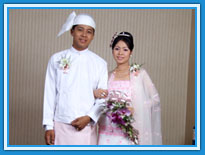 Bamar is the ethnic majority of Myanmar and more
than 65 percents of the population are Bamar.
Ayeyarwaddy delta, the whole central Myanmar and the
valleys along the Ayeyarwaddy River are inhibited by
Bamars. Over 90 percent of Bamar are Buddhist. But
also there are Christians. The official language of
Myanmar is Burmese. They migrated from china into
Ayeyarwady valley in upper Myanmar around 1200 years
ago. They had tried to dominate the Mon and Pyu
ethnic groups and later they gained successes. Bamar
traditional dresses are sarongs (paso), shirts and
jackets for men and sarongs (htamain) and blouses
for women. During the ceremony men wear turbans of
cloth called gaung baung.
Bamar is the ethnic majority of Myanmar and more
than 65 percents of the population are Bamar.
Ayeyarwaddy delta, the whole central Myanmar and the
valleys along the Ayeyarwaddy River are inhibited by
Bamars. Over 90 percent of Bamar are Buddhist. But
also there are Christians. The official language of
Myanmar is Burmese. They migrated from china into
Ayeyarwady valley in upper Myanmar around 1200 years
ago. They had tried to dominate the Mon and Pyu
ethnic groups and later they gained successes. Bamar
traditional dresses are sarongs (paso), shirts and
jackets for men and sarongs (htamain) and blouses
for women. During the ceremony men wear turbans of
cloth called gaung baung.
Kachin
 One of the major ethnic group of Myanmar and live
in Kachin State, in the northern part of Myanmar.
But some Kachins can be found on the mountain ranges
of northern Shan State and Kyaington. They arrived
here and inhabited in the 15th and 16th century.
They call themselves Jingphaw. They speak their own
language. Almost half of Kachins are Christians, but
also there are Buddhists and animists. Women often
dress the black jackets with silver decorations.
They also wear wool skirts made in bright colors.
The men wear black and wide pants and also turbans.
The famous festival of Kachin is Manaw festival
which holds in January.
One of the major ethnic group of Myanmar and live
in Kachin State, in the northern part of Myanmar.
But some Kachins can be found on the mountain ranges
of northern Shan State and Kyaington. They arrived
here and inhabited in the 15th and 16th century.
They call themselves Jingphaw. They speak their own
language. Almost half of Kachins are Christians, but
also there are Buddhists and animists. Women often
dress the black jackets with silver decorations.
They also wear wool skirts made in bright colors.
The men wear black and wide pants and also turbans.
The famous festival of Kachin is Manaw festival
which holds in January.
Kayah
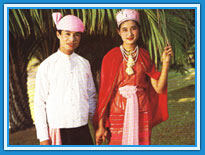 Kayah is also known as Karenni, is a subgroup of
Karen. They descend from Sino-Tibetan group. They
live in Kayah State which is full of mountains and
hills. Loikaw is the main city of Kayah.
Kayah is also known as Karenni, is a subgroup of
Karen. They descend from Sino-Tibetan group. They
live in Kayah State which is full of mountains and
hills. Loikaw is the main city of Kayah.
Karen
 Karen is one of the major ethnic groups of
Myanmar and most of them live in Karen State, in the
hills of eastern Myanmar. Kayin is the subgroup of
Tibeto-Burman group. Approximately 7 percent of
Myanmar population is Kayin. So Kayin is the third
biggest population after Bamar and Shan. But some
are found in Kayah State, southern Shan State,
Ayeyarwady region, Tanintharyi Region and in western
Thailand. Karens were animists in the past, but
today the majority is Buddhist, there are also
Christians. There are 5 different subgroups of Kayin
according to the region where they live.
Karen is one of the major ethnic groups of
Myanmar and most of them live in Karen State, in the
hills of eastern Myanmar. Kayin is the subgroup of
Tibeto-Burman group. Approximately 7 percent of
Myanmar population is Kayin. So Kayin is the third
biggest population after Bamar and Shan. But some
are found in Kayah State, southern Shan State,
Ayeyarwady region, Tanintharyi Region and in western
Thailand. Karens were animists in the past, but
today the majority is Buddhist, there are also
Christians. There are 5 different subgroups of Kayin
according to the region where they live.
Chin
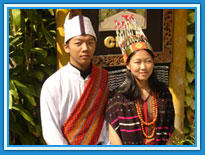 Chin is one of the ethnic groups in Myanmar. The
Chins are mainly found in the western part of
Myanmar. They descend from Tibeto-Burman groups and
the population is about 1.5 million. They also live
in Mizoram, Manipur and Assam. Some of them are
found in Rakhine State. They arrived in Myanmar
around 9th century and settled in Chin State in 13th
century. Like the other tribes in Myanmar they were
traditionally animists. During the colonial period
most of them converted to Christianity. Almost 90
percent of the population is Christians. There are
also many subgroups in Chins.
Chin is one of the ethnic groups in Myanmar. The
Chins are mainly found in the western part of
Myanmar. They descend from Tibeto-Burman groups and
the population is about 1.5 million. They also live
in Mizoram, Manipur and Assam. Some of them are
found in Rakhine State. They arrived in Myanmar
around 9th century and settled in Chin State in 13th
century. Like the other tribes in Myanmar they were
traditionally animists. During the colonial period
most of them converted to Christianity. Almost 90
percent of the population is Christians. There are
also many subgroups in Chins.
Mon
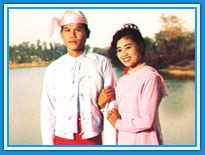 Mon is a major ethnic group of Myanmar. They live
mainly in Mon State. The population of Mon is about
6 million. They were living in Myanmar earlier than
the other groups with great civilization. They
practiced Buddhism firstly in Myanmar with the help
of Sri Lanka. They adopted the Pallava script and
created their own writing. So Mon was responsible
for the spread of Theravada Buddhism in Myanmar and
Thailand. There are so many influences of Mon
culture on Myanmar culture such as architect,
language and religion. Being the civilized people
there are so many traditional heritages. Some of
them are spiritual dances, crocodile xylophone, harp
and flat guitar.
Mon is a major ethnic group of Myanmar. They live
mainly in Mon State. The population of Mon is about
6 million. They were living in Myanmar earlier than
the other groups with great civilization. They
practiced Buddhism firstly in Myanmar with the help
of Sri Lanka. They adopted the Pallava script and
created their own writing. So Mon was responsible
for the spread of Theravada Buddhism in Myanmar and
Thailand. There are so many influences of Mon
culture on Myanmar culture such as architect,
language and religion. Being the civilized people
there are so many traditional heritages. Some of
them are spiritual dances, crocodile xylophone, harp
and flat guitar.
Rakhine
 Rakhine is one of Myanmar ethnic groups and live
in Rakhine State. They believe that they were one of
the first groups who practiced Buddhism in Southeast
Asia. Rakhine culture is also similar to India like
Myanmar. Rakhine is closer with India than Barma, so
there are many Indian Influences in the culture of
Rakhine, such as literature, music, and cuisine.
According to their words Rakhine began in 3325 BC
but archaeological evidence show that Rakhine began
in the 1st century AD.
Rakhine is one of Myanmar ethnic groups and live
in Rakhine State. They believe that they were one of
the first groups who practiced Buddhism in Southeast
Asia. Rakhine culture is also similar to India like
Myanmar. Rakhine is closer with India than Barma, so
there are many Indian Influences in the culture of
Rakhine, such as literature, music, and cuisine.
According to their words Rakhine began in 3325 BC
but archaeological evidence show that Rakhine began
in the 1st century AD.
Shan
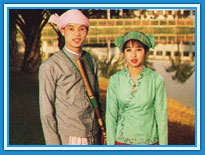 Shan is an ethnic group of Myanmar and inhabit in
Shan State. Some are found in Mandalay Division,
Kachin State and Kayin State. The population is
approximately 6 million. Taunggyi, lashio, Kyaington
are the main cities of ethnic Shan. They speak their
own language. They descend from Tai-Shan ethnic
group. Almost all of Shans are Buddhists but in the
farther mountain ranges there are some animists.
Shan is an ethnic group of Myanmar and inhabit in
Shan State. Some are found in Mandalay Division,
Kachin State and Kayin State. The population is
approximately 6 million. Taunggyi, lashio, Kyaington
are the main cities of ethnic Shan. They speak their
own language. They descend from Tai-Shan ethnic
group. Almost all of Shans are Buddhists but in the
farther mountain ranges there are some animists.
We also would like to introduce some small
tribes, Pa-O, Padaung, Palaung, Lahu, Lishu, Akhar,
Naga and how they stand their life in different
geographical location, culture, climate and customs.
Pa-O
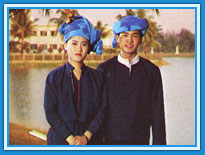 The ethnic Pa o is the second largest group in
Shan state. Every man and woman wraps their head
with towels and wears black color dresses. Men wear
the black trousers and jackets and women wear also
long black sleeve jackets and skirts, wounded on
their calf by black legging on which sometimes wound
silver threads.
The ethnic Pa o is the second largest group in
Shan state. Every man and woman wraps their head
with towels and wears black color dresses. Men wear
the black trousers and jackets and women wear also
long black sleeve jackets and skirts, wounded on
their calf by black legging on which sometimes wound
silver threads.
Many Pa-O people settled down near Taunggyi in
Shan state, their main business is hillside
cultivation. They cultivate Oranges, Ginger, Potato,
Tomato, Corn, Rice and some vegetables etc, If you
want to know about this tribes please come to join
hot air balloons festival in November (Taunggyi
Tazaungdine Festival).
Palaung
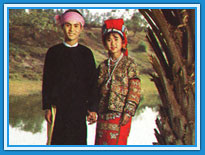 Palaung is a sub-group of Shan like Pa-O. They
live in Shan mountain ranges. Most of them are
living in the north of Shan state but some can be
found in the regions of Kyaington and Tnaunggyi.
According to the regions where they live there are
many different Palaung groups. Each group has its
own costume in different color and style.
Palaung is a sub-group of Shan like Pa-O. They
live in Shan mountain ranges. Most of them are
living in the north of Shan state but some can be
found in the regions of Kyaington and Tnaunggyi.
According to the regions where they live there are
many different Palaung groups. Each group has its
own costume in different color and style.
Padaung
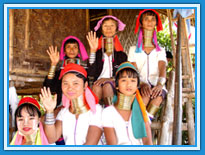 Most of Padaung live in Kayah state and is one of
the ethnic groups of Karan. Padaung people are well
known as “Long-Necked Women”. All Padaung women wear
heavy brass rings around the neck, arms and calve.
Why did they wear these brass rings? According their
legend they wear it to protect wild animals for
especially tigers when they go away from home to the
jungle to work..
Most of Padaung live in Kayah state and is one of
the ethnic groups of Karan. Padaung people are well
known as “Long-Necked Women”. All Padaung women wear
heavy brass rings around the neck, arms and calve.
Why did they wear these brass rings? According their
legend they wear it to protect wild animals for
especially tigers when they go away from home to the
jungle to work..
Naga
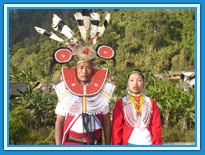 These people descend from Tibeto-Bamar group and
live in Chin state near India-Myanmar border. They
live mostly around Patkoi mountain ranges. They are
well known for the traditional attire for especially
their hats which made of cane decorated by tusks of
the wild boars, bird feathers, bear fur and human
hairs.
These people descend from Tibeto-Bamar group and
live in Chin state near India-Myanmar border. They
live mostly around Patkoi mountain ranges. They are
well known for the traditional attire for especially
their hats which made of cane decorated by tusks of
the wild boars, bird feathers, bear fur and human
hairs.
The Naga are normally barely dressed except in
the near zero temperature. When they need the warmth
they get from the woven blankets. Sometimes the
blankets are woven with scenes of the wearer’s life
such as his victory over wild elephants or ferocious
tigers or his skill in hunting deer. The more
venerated old men have sewn blankets with cowry
shells as a symbol of their leadership.
The biggest Naga Festival is the New Year
Festival call ‘’Kaing Bi’’. It holds every year in
January.
Lahu
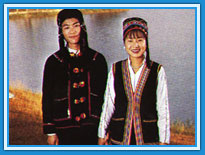 Lahu is one of Myanmar ethnic tribes. Most of
them are found on the mountain ranges of Kyaing Ton
at the eastern Shan State. The historians believe
that they descend from Tibeto-Burman group. They are
mainly living on hillside cultivation and sometimes
hunting. The men and women of Lahu wear black
dresses. The women’s dresses are decorated with
earplugs, necklaces, bracelets and rings which are
made of silver.
Lahu is one of Myanmar ethnic tribes. Most of
them are found on the mountain ranges of Kyaing Ton
at the eastern Shan State. The historians believe
that they descend from Tibeto-Burman group. They are
mainly living on hillside cultivation and sometimes
hunting. The men and women of Lahu wear black
dresses. The women’s dresses are decorated with
earplugs, necklaces, bracelets and rings which are
made of silver.
Akha
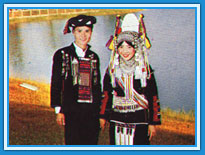 One of the minor tribe, living on the mountain
ranges around Kyaing Ton, is Akha. They are known as
Kaw but they prefer to be called as Akha. They are
earning their lives on agriculture. Most of them are
Buddhist but some are Animists. Akha men wear dark
blue trousers, Jackets and headbands. Women wear
black jackets and skirts decorated with silverwares.
One of the minor tribe, living on the mountain
ranges around Kyaing Ton, is Akha. They are known as
Kaw but they prefer to be called as Akha. They are
earning their lives on agriculture. Most of them are
Buddhist but some are Animists. Akha men wear dark
blue trousers, Jackets and headbands. Women wear
black jackets and skirts decorated with silverwares.